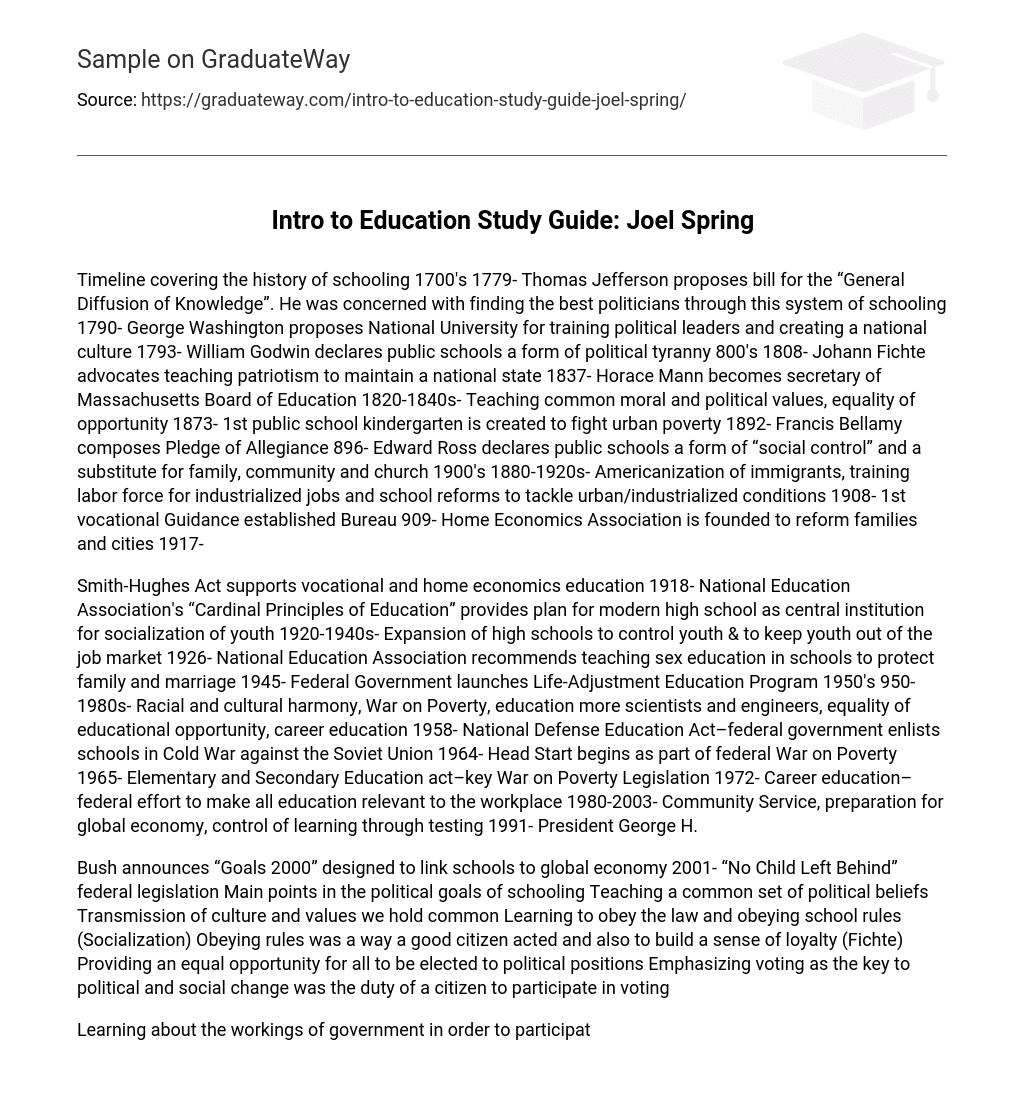- 1779- Thomas Jefferson proposes bill for the “General Diffusion of Knowledge”. He was concerned with finding the best politicians through this system of schooling
- 1790- George Washington proposes National University for training political leaders and creating a national culture
- 1793- William Godwin declares public schools a form of political tyranny
- 1808- Johann Fichte advocates teaching patriotism to maintain a national state
- 1837- Horace Mann becomes secretary of Massachusetts Board of Education
- 1820-1840s- Teaching common moral and political values, equality of opportunity
- 1873- 1st public school kindergarten is created to fight urban poverty
- 1892- Francis Bellamy composes Pledge of Allegiance
- 1896- Edward Ross declares public schools a form of “social control” and a substitute for family, community and church
- 1880-1920s- Americanization of immigrants, training labor force for industrialized jobs and school reforms to tackle urban/industrialized conditions
- 1908- 1st vocational Guidance established Bureau 909- Home Economics Association is founded to reform families and cities
- 1917- Smith-Hughes Act supports vocational and home economics education
- 1918- National Education Association’s “Cardinal Principles of Education” provides plan for modern high school as central institution for socialization of youth
- 1920-1940s- Expansion of high schools to control youth & to keep youth out of the job market
- 1926- National Education Association recommends teaching sex education in schools to protect family and marriage
- 1945- Federal Government launches Life-Adjustment Education Program
- 1950’s 950-1980s- Racial and cultural harmony, War on Poverty, education more scientists and engineers, equality of educational opportunity, career education
- 1958- National Defense Education Act–federal government enlists schools in Cold War against the Soviet Union
- 1964- Head Start begins as part of federal War on Poverty
- 1965- Elementary and Secondary Education act–key War on Poverty Legislation
- 1972- Career education–federal effort to make all education relevant to the workplace
- 1980-2003- Community Service, preparation for global economy, control of learning through testing 1991- President George H. Bush announces “Goals 2000” designed to link schools to global economy
- 2001- “No Child Left Behind” federal legislation Main points in the political goals of schooling.
Timeline Covering the History of Schooling
The political goals of schooling have evolved over time in the United States. In 1779, Thomas Jefferson proposed a bill for the General Diffusion of Knowledge to find the best politicians through education. In 1790, George Washington proposed a National University for training political leaders and creating a national culture. In 1837, Horace Mann became secretary of Massachusetts Board of Education and advocated for teaching common moral and political values. The Americanization of immigrants, training the labor force for industrialized jobs, and tackling urban/industrialized conditions were the focus of school reforms in the late 1800s and early 1900s. The expansion of high schools in the 1920s aimed to control youth and keep them out of the job market. In the 1950s and 1960s, efforts were made to promote racial and cultural harmony, equality of educational opportunity, and prepare students for the global economy. Federal legislation, such as the No Child Left Behind Act in 2001, has also aimed to control learning through testing.
Cite this page
Timeline Covering the History of Schooling. (2016, Oct 02). Retrieved from
https://graduateway.com/intro-to-education-study-guide-joel-spring/





